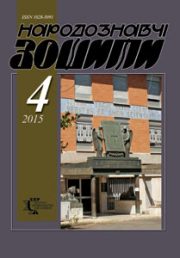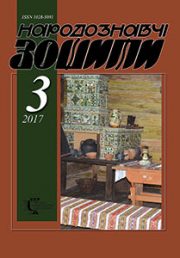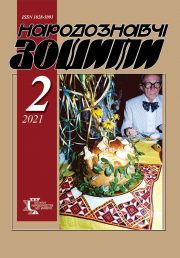The Ethnology Notebooks. 2020. № 4 (154), 892—906
UDK 75.036.7(477.83-25)”195/…”(043.5)
DOI https://doi.org/10.15407/nz2020.04.892
BRATIUK Nadija
- Postgraduate student of the Lviv
- National Academy of Arts
- 38, Kubiyovycha St., 79011, Lviv, Ukraine
- Contacts: e-mail: mikulanadia@gmail.com
Abstract. Introduction. The Ukrainian art of the second half of the ХХ — the beginning of the ХХІ century having occurred under the strict control of the Soviet system developed in two parallel lines — official and unofficial. As one of the forms of the alternative unofficial art education bearing the Western European vector of creativity emerged the «Underground Academy of K. Zvirynsky». For the artists-sixtiers the freedom of expression became one of the fundamental worldview and aesthetic principles. That was the period of the internal self-isolation, when artists worked in workshops and their works were revealed only to the reliable narrow circle of the like-minded, predominantly fellow artists. This was the process of liberating the art from the dictatorship of the totalitarian system, the new path of the development of the Ukrainian artistic thinking and self-identification was conceiving.
Problem Statement. The article deals with the creativity of the artists originating from K. Zvirynsky school, i. e. P. Markovych and Z. Flinta, as regards the expressionistic tendencies.
Purpose. The artistic analysis of the paintings has been carried out based on the visual material. The technical preferences of the painters in the sphere of the pictorial art have been defined, as well as the peculiarities and features relevant for expressing the expressionistic language have been determined. The article analyzes the conception of the expressive tendencies and inspiration sources, which were applied in the numerous composition structures, color palette and brush work of the mentioned artists.
Methods. The following methods are in the article: comparative method, method of artistic analysis of works, method of analysis and synthesis, formal analysis of stylistic features of the author’s picturesque handwriting.
Results. The article analyzes the works of P. Markovych «Still Life with Ceramics» (1961), «At the Table» (1962), «The Decorative Landscape» (1962), «Madonna» (1967), «Anchar — the Tree of Death» (1968), and of Z. Flinta «The Flowers on the Bench» (1961), «Cactus» (1960s), «The Yard» (1966).
In the works of P. Markovych and Z. Flinta the inclination towards still life, landscape, associative canvases and compositions is observed. Both painters deliberately opt for the nature and objects. The distinctive peculiarity of the students of K. Zvirynsky school is the conciseness of the composition structure. The painters focus their attention on the inner spiritual turmoil, which harmoniously complement the figurative and conceptual colouring of the piece of art.
Conclusion. On the example of the visual material we were able to reveal the origins and peculiarities of the development of the expressionistic tendencies in the works of Lviv artists of 1960s. It can be stated that the pictorial legacy of P. Markovych and Z. Flinta contains the expressionistic vector among the artistic transformations of that time and the pursuits of the Lviv environment in 1960s, as well as is the integral part of the all-Ukrainian art process.
Keywords: students of K. Zvirynsky school, Lviv painting, expressionism, pictorial art.
Received 4.05.2020
REFERENCES
- Batih, M.I. (Ed.). (1986). Creative and organizational activity of the Lviv Union of Artists of the Ukrainian USSR. Lviv: [b. v.] [in Ukrainian].
- Holubets, O. (2002). Breakthrough of the Sixties. From a distant time. Visnyk Lvivskoi natsionalnoi akademii mystetstv (Issue 12). Lviv: LNAM [in Ukrainian].
- Smyrna, L. (2016). Ukrainian artistic non-conformism. Art Ukraine (Part 1). Retrieved from: http://artukraine.com.ua/a/ukrainskiy-misteckiy-nonkonformizm-chastina-1/#.Wp_HD3yYP4Z (data zvernennia: 8.02.19) [in Ukrainian].
- Markovych, P. (2006). Art Album. Life. Art. Lviv; Siietl: Kolir Pro Servis [in Ukrainian].
- Bazhan, O., & Smolii. V.A. (Ed.). (2013). Entsyklopediia istorii Ukrainy: v 10 t. In-t istorii Ukrainy NAN Ukrainy(Vol. 10, pp. 641).Kyiv: Naukova dumka. Retrieved from: http://history.org.ua/LiberUA/978-966-00-1359-9/978-966-00-1359-9.pdf (data zvernennia: 2.02.19) [in Ukrainian].
- Seko, Y., & Aleksiievets, L.M. (Ed.). (2010). Historical discourse of the Ukrainian sixties. Mizhnarodnyi zbirnyk naukovykh prats Ukraina — Yevropa — Svit. Seriia: Istoriia, mizhnarodni vidnosyny (Ussue 5, pp. 126—133).Ternopil: Vyd-vo TNPU im. V. Hnatiuka [in Ukrainian].
- Kosmolinska, N., & Chaban-Zvirynska, Kh. (Eds.). Art at the turn of the millennium: Carlo Zvirynsky and art of the 1960s. Lviv: Braty Syrotynski i K. [in Ukrainian].
- The sealed circle of Karl Zvirynsky. Booklet of the exhibition [in Ukrainian].
- Zvirynskyi, K., & Zvirynska-Chaban, Kh. (Ed.). (2017). All my painting is a prayer: memories, interviews, reflections, articles. Lviv: Manuskrypt [in Ukrainian].
- Pecheniuk, T., & Zvirynska, Kh. (Eds.). (2002). Karlo Zvirynsky (1923—1997): Memoirs, articles, painting. Lviv: Malti-M. [in Ukrainian].
- Holubets, O. (2001). Between freedom and totalitarianism: the artistic milieu of Lviv in the second half of the ХХ century. Lviv: Akademichnyi ekspres [in Ukrainian].
- (1988). Markovych Petro. Exhibition catalog. Lviv: Oblpolihrafvydav [in Ukrainian].
- Danyliv-Flinta, I., & Kosmolinska, N. (Eds.). (2010). Zenovyi Flinta: album. Lviv: [b. v.] [in Ukrainian].
- Shymchuk, Ye. (1995). Zenovyi Flinta: strokes to the portrait. Almanakh’94: myst. nauk-popul. iliustr. Shchorich (Pp. 31—32). LNAM. Lviv: Kompaniia Herdan [in Ukrainian].
- Protsiv, I. (2012). Non-conformism at the turn of the 1950s and 1960s. The Ethnology Notebooks, 5 (107), 919—822[in Ukrainian].
- Mysiuha, B. (2015). Zenovyi Flinta Syncretism: Between Principle and Creative Freedom. Retrieved from: http://prostir.museum/ua/post/36034 (data zvernennia: 2.03.19) [in Ukrainian].
- Maherovskyi, O. (2010). Aspects of creative guest by Zenovyi Flinta. Visnyk Kharkivskoi derzhavnoi akademii dyzainu i mystetstv. Mystetstvoznavstvo. Arkhytektura (Issue 1). Retrieved from: http://nbuv.gov.ua/UJRN/had_2010_1_34 (data zvernennia: 12.11.18) [in Ukrainian].
- Pecheniuk, T., & Zvirynska, Kh. (Eds.). (2002). Carlo Zvirinsky (1923—1997): Memoirs, articles, painting. Lviv: Malti-M. [in Ukrainian].
- Danyliv-Flinta, I., & Kosmolinska, N. (Eds.). (2010). Zenovyi Flinta: album. Lviv: [b. v.] [in Ukrainian].
- Holubets, O. (2010). Interrupted flight. Artaniia: kulturolohiia, mystetstvo, publitsystyka, istoriia (Issue 1, book 18, pp. 148—153). Kyiv: Sofiia-A [in Ukrainian].
- (2011). Flinta Zenovyi Petrovich. Lvivska natsionalna akademiia mystetstv. Kyiv: Lohos Ukraina. Retrieved from: http://www.logos.biz.ua/proj/lnam/online/lnam–22-23.pdf (data zvernennia: 6.01.19) [in Ukrainian].
- Shymchuk, Ye. (Ed.). (1995). Zenovyi Flinta: album. Lviv: Kompaniia Gerdan [in Ukrainian].
- Shymchuk, Ye. (Ed.). (1989). Zenovyi Flinta (1935—1988): Painting. Graphics Ceramics. Lviv: Atlas [in Ukrainian].
- (1992). Lviv painting 60—80 years. Kataloh: Transliatsiia; Lviv: Krai [in Ukrainian].
- Kosmolinska, N., & Chaban-Zvirynska, Kh. (Eds.). (1998). Art at the turn of the millennium: Carlo Zvirynsky and art of the 1960s. Lviv: Braty Syrotynski i K. [in Ukrainian].
- (2014). Modern painting of Lviv. Lviv: BAK [in Ukrainian].






